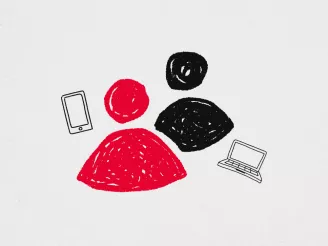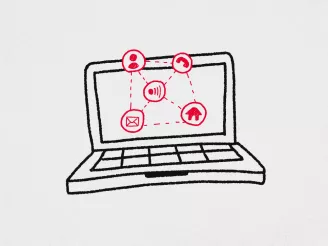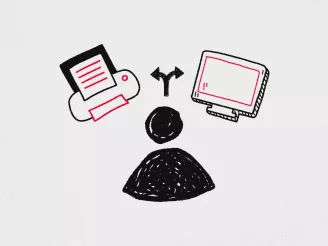Productivity tips that benefit both SME leaders and employees
Real-world working can mean a lot of positive things today. Maybe it’s being able to jump on a quick call with your colleague in another country. Perhaps it’s the choice of collaborating either physically face-to-face or virtually with your team.
But despite all of the perks that come with hybrid working, one third of SMEs say a lack of app skills is having an impact on productivity. While most consider employees to have the same amount of, or more productivity at home, nearly a quarter (22%) of SMEs say teams were less productive when working from home. Therefore, it’s clear that what’s working for most isn’t working for all.
With increasingly disparate, sometimes tech-naïve workforces, businesses need to find ways to keep motivation, morale, and productivity levels high. To help, we’ve outlined eight ways SMEs can do this effectively.
Establish best working practices
Implement communication channels
People working from different locations is now the norm for many businesses. And no matter the location, communication is key. However, less-than-ideal tech capabilities are affecting productivity. According to our research, 27% of European SMEs say a lack of skills with Office 365 is having an impact on productivity.
SMEs need to establish clear channels for communication between teams. Whether it’s the type of platforms being used, response times or availability – people need to know what’s expected of them and be given the right tools to work effectively. Of course, this means when onboarding any new communication channels, or increasing the use of Microsoft 365, the relevant training should be provided.

Check in with people
Not everyone’s experience of hybrid work will be the same. Someone who is more tech-savvy might find it easier to adapt quickly, whereas others may need more guidance along the way. That’s why it’s important to always check in with the whole team, and assess when and where support might be needed.
Are there any concerns around the new technology your business has introduced? What are your teams thoughts on implementing AI-embedded software? Opening up opportunities for different individuals to share feedback – whether those are struggles or positive experiences – is a good way to know if new ways of working are actually working. It’s also an ideal way to test the waters with anything new you bring into the fold, particularly regarding the use of AI.

Introduce time management techniques
Employees benefit from the flexibility of hybrid work – but irregularity in routines and multiple environments can have an impact on productivity. To address this without adding unwanted pressure, it’s important to explore time-management techniques.
Factoring regular breaks into an employee’s working day – whether they’re at home or in the workplace – can be good for improving concentration and productivity during work. While frequent breaks can also help reduce stress and sustain motivation, implementing tools like Microsoft Planner can help keep work organised and expectations transparent. At the same time, utilising AI technology for daily tasks can not only assist with faster scheduling and project management, but help employees save time; allowing them to focus on being productive in other areas of work.

What the data says
Technology, collaboration, and training
Invest in training
New tech, with all the benefits it can bring, can create employee anxieties about using it. This uncertainty and unfamiliarity can have a direct impact on productivity. With a digital skills gap becoming ever-present across Europe, effective technology training has never been more needed in businesses.
For any new technology or platforms, scheduling in-person training sessions to allow employees time and space to adjust is crucial. According to our research, a quarter (25%) of SMEs cite employees’ ability to use software as one of the biggest challenges they will face over the next 12 months from a technology perspective. Our IT consultancy services can help keep employees in-the-know about the latest technology and software and how to get the most out of it.

Enlist tech-native guardians
In-person training sessions are a great way to run through what it is the new technology does. But sometimes, the real learning comes from actually using it. And chances are not every employee in a team will be able to tackle new tech with ease.
Enlisting tech-native guardians, or ‘tech buddies’, can help take some of the pressure away for individual struggles. Pairing up your less digitally capable employees with those who live and breathe technology is a great way to not only keep teams productive, but boost social bonds as well.

Maximise collaboration
As daily work and team communication has shifted online, finding the right set-up to enable collaboration has grown in importance. And with the technology available today, it shouldn’t matter if a team is sat in the same room or communicating from across continents.
However, 32% of SME respondents cited that a lack of skills with apps (for example video conferencing software), has had a negative impact on productivity when working from home. To avoid any disruption to collaboration – and productivity – it’s worth implementing the digital tools that can both enhance productivity and bring teams together. And today, there are a range of audio-visual (AV) solutions that can be leveraged to ensure consistent collaboration experiences – whether employees are working from the meeting room or their bedroom.

Over a third of SMEs find home desk or table setups to be a productivity issue.
Positivity and flexibility
Flex to individual needs
One person’s experience of working remotely might not be the same as another. A ‘home office’ for someone might be just as good as the workplace, yet for someone else it might be full of distractions. And if working remotely is an expectation for employees, productivity can be affected. In fact, over a third (35%) of SMEs found that home desk or table setups are a productivity issue.
When it comes to your remote and hybrid work policies, make sure to tailor them to the individual person, rather than having one blanket arrangement for everyone. It’s also important to give employees equal opportunity to work at home the way they would in the workplace. As 39% cite home broadband as a blocker for remote work productivity, make sure employees have access to the right technical support wherever they’re working from.

Build a positive culture
It’s not surprising that negative working environments can foster negative work experiences. And when it comes to attitudes to work, it’s unlikely those with a bad experience are going to be productive. To keep morale high, small wins – whether that’s getting good customer feedback or hitting a daily target – should be celebrated in the same way as the big.
Make your working environments, and culture, a safe space that celebrates success as it happens and encourages exploration. The more employees know they’re doing well, the more likely they’ll be to set that standard moving forward. And as mistakes do happen, having this kind of culture helps people know that making mistakes is okay – and can create positive learning opportunities.

What the data says
Make productivity your priority
Attaining and maintaining high employee morale is possible in real-world working. With greater flexibility, it’s easier for employees to get more from the typical working day. That being said, keeping an eye on the best drivers of productivity is essential.
As a long-term fixture in office environments, Sharp can help your teams stay productive through change – whether that’s with effective collaboration and communication tools, expert IT training services, or even AV solutions tailored to your organisation’s needs.

Want to discover how Sharp can help you power productivity? Explore our range of services and solutions.
¹ 2023 research conducted with 5770 Professionals within SMEs from the UK, Sweden, Netherlands, Switzerland, Germany, France, Italy, Spain, Austria, Poland and Belgium (IT Decision Makers and people who are responsible for purchasing IT within the company)

